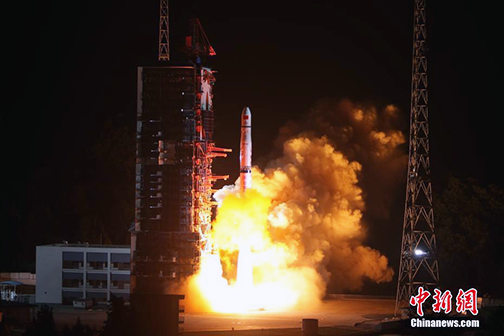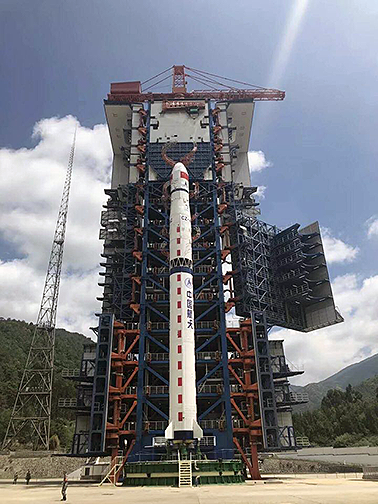
The Long March 4C carrying the Queqiao Chang'e-4 lunar relay satellite lifts off from the Xichang Satellite Launch Center
Photo is courtesy of CNS.
As has been reported by Andrew Jones of gbTimes, China has successfully launched a lunar communications relay satellite designed to support an unprecedented mission to put a lander and rover on the far side of the Moon in late 2018, as well as carry out pioneering astronomy.
The Chang’e-4 relay satellite, accompanied by two microsatellites, lifted off atop a Long March 4C rocket from the Xichang Satellite Launch Centre at 21:28 UTC on Sunday (05:28 Beijing time, May 21). The spacecraft was successfully inserted into a lunar transfer orbit and separated from the rocket’s upper stage, the China Aerospace Science and Technology Corporation (CASC) — the main contractor for the space program — confirmed just under an hour after the launch.
Named ‘Queqiao’ — referencing a ‘Magpie Bridge’ from a Chinese folklore of lovers crossing the Milky Way — the relay satellite is now on an 8-to-9 day journey to the second Earth-Moon Lagrange point (E-M L2), which is some 60-80,000 kilometres beyond the Moon and nearly half a million kilometres from Earth.

The Long March 4C rocket at the Xichang Satellite Launch Centre.
Photo is courtesy of Marc Klein Wolt.
The main aim of the mission is to provide a means of communications for setting down and operating a lunar lander and rover on the far side of the Moon, a feat that has never been attempted. As the Moon is ‘tidally locked,’ taking the same time to go around the Earth as it does to rotate once, the lunar far side never faces the Earth. The landing mission thus requires a communications relay satellite with simultaneous line-of-sight to both the lander and rover on the Moon and terrestrial ground stations. The gravitationally stable E-M L2 will allow for a stable orbit from which the satellite can perform this task.
Queqiao will make a lunar swing-by to send it towards its intended destination beyond the Moon and use its own propulsion to enter a halo orbit around the Lagrange point. Once in place, the 448 kg. CAST100 satellite, developed by the China Academy of Space Technology (CAST), a spacecraft maker under CASC, will undergo testing of its 4.2m parabolic antenna and functions ahead of the landing mission which will take place in around six months.
The relay satellite marks China’s fifth lunar mission, following two orbiters, Chang'e-1 in 2007 and Chang’e-2 in 2010), the 2013 Chang'e-3 lander and rover, and a 2014 test lunar return mission. In 2019 China will launch the Chang’e-5 mission to collect 2 kg. of samples from the Moon and bring them to Earth.
This launch was China’s 15th of the year, with the country aiming for a national record of around 40 during 2018.
Following the landing mission, the relay satellite will deploy three, 5 meter, monopole antennas, which will be used for very low frequency astronomy that is not possible on Earth due to the planet’s atmosphere. The Netherlands-China Low-Frequency Explorer (NCLE), developed by Radboud University and others, will attempt to detect a low frequency signal from the ‘dark ages’ of the universe, a few hundred million years after the Big Bang and before the first stars begin to shine. Other objectives, said Marc Klein Wolt of Radboud University and NCLE project leader, include surveying the solar system at these frequencies, and act as a pathfinder for future missions.
Asked if NCLE could also — despite not being a science objective for the team — contribute to the search for extraterrestrial intelligence (SETI), Klein Wolt said that, in principle, it could, as a new window on the universe is opening, but he's not expecting to find ET.
Two microsatellites, Longjiang-1 and -2 (River Dragon-1 and -2), were also aboard the launch and will enter highly elliptical lunar orbits to perform their astronomy tasks. The 45-kg, 50x50x40 cm satellites developed by the Harbin Institute of Technology (HIT) in Heilongjiang Province will use 1 meter antennas to test low frequency radio astronomy and space-based interferometry. Mainly a technical verification for future missions, the pair will also carry out amateur radio experiments, with one will also carrying a small optical camera developed by Saudi Arabia.
To read the complete, informative article, please access this direct link to the gbTimes infopage...

